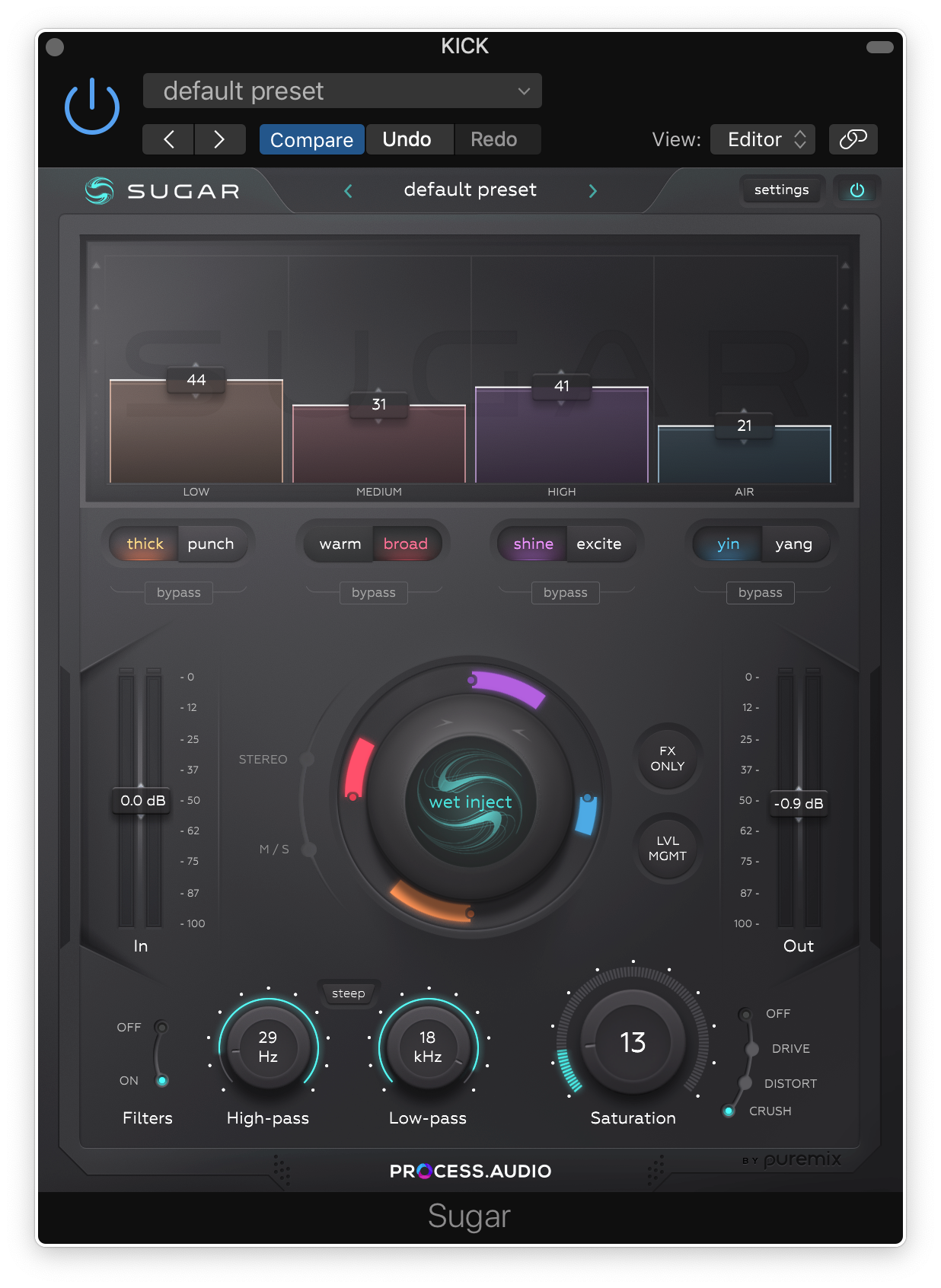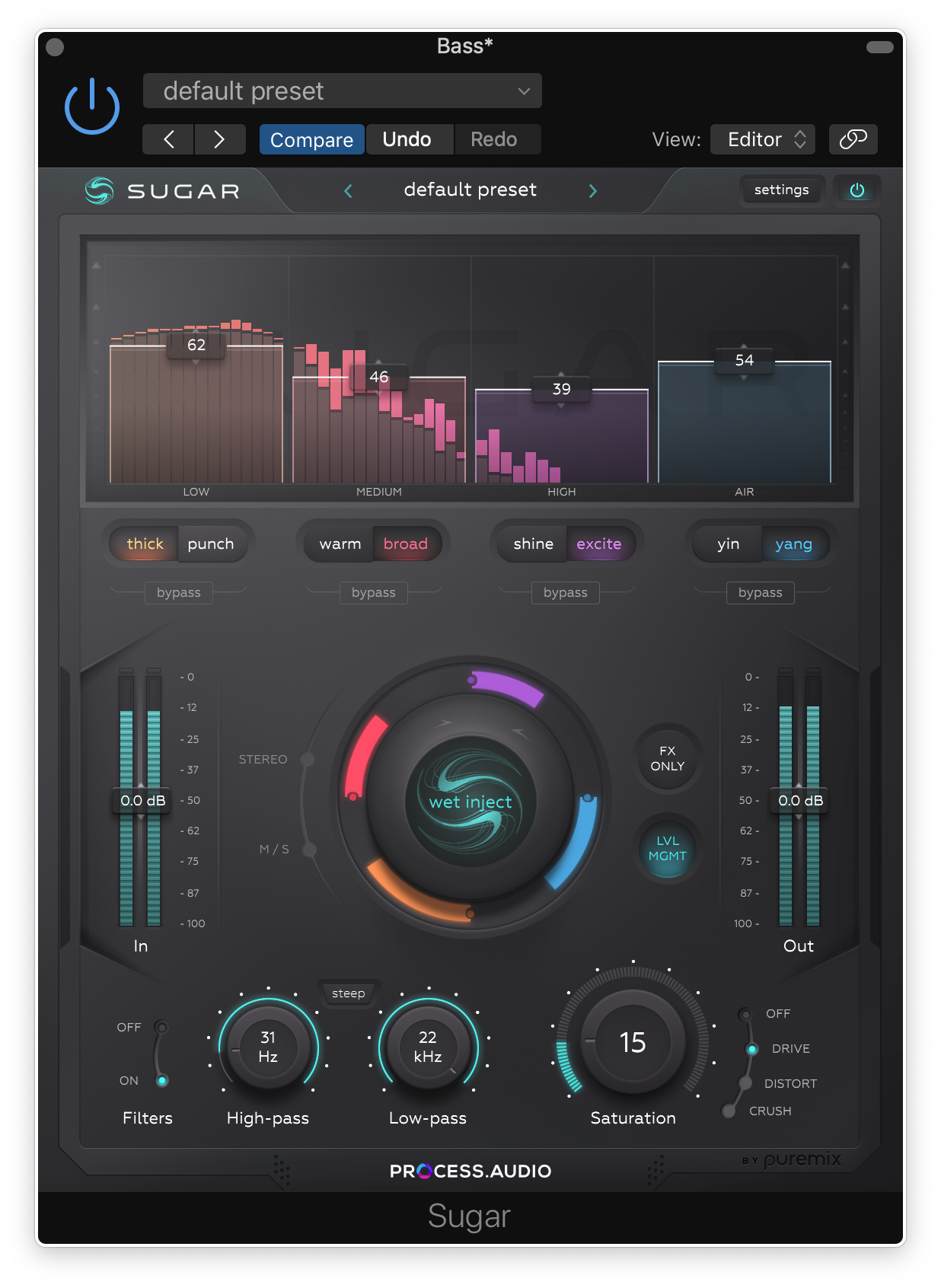Sweet Bass: Enhance your Low End
Sugar excels as a bass enhancer
Sugar is such a versatile plugin that you can use it to improve any individual track or mix bus. With four enhancer bands and the choice of three types of saturation, you have a lot of sonic options at your disposal for your bass enhancement or anything. One of the areas in which it excels is as a bass enhancer for upgrade your song. Whether you put it on synth bass, bass guitar, kick drum, drum loop or any source whose frequency range is predominantly in the low-frequency range, Sugar is the perfect tool to make it sound more powerful and focused.
A Kick in Time
If you’re working with multitrack drums on your mix bus, you can use Sugar individually on specific kit elements like the low end, including the kick. Because of its abilities as a bass enhancer, Sugar can help you beef up the kick’s low end and bring out some of its midrange tones.

One of Sugar’s many strengths is as a bass enhancer.
Once you have a basic mix going and have checked your drums’ phase relationships, listen in context of all the tracks. What do you notice that’s lacking in the kick? Is it the low end? Is it the sound of the beater—the sort of “clicky” part of the kick? Sugar can help you with either.
Solo the drums—but not the kick by itself. In a drum mix, the overheads pick up a lot of kick and snare, so they’re going to be an essential part of the sound of the close-miked drums (kick, snare and toms). Make sure your overheads are on.
If you’re using two kick mics—in and out—it might be easier to create a subgroup that’s being fed by both kick tracks and insert Sugar on that. Once you have an idea of the sound you’re going for, insert Sugar on the kick track.
Slowly bring up the low end
If you want to add more low end, begin with Sugar’s Low band and start bringing it up. You’ll notice how the sound fattens up. Try both the Thick and Punch modes to see which works better. Both will beef up the sound. Thick will make it a little fatter than Punch, but Punch will boost the transients more.
Bring up the Medium slider some to see if it helps. Again, try both the Warm and Broad options. You’ll start to hear some of the higher parts of the kick, but you’ll get the most enhancement of the kick click with the High slider.
Make sure you have the Level Management button turned on because Sugar is boosting when you push up those sliders, and Level Management keeps all those low ends from getting out of control. You also might want to put a bit of Saturation on to warm it just a tad.
Here’s an example of Sugar being used as a bass enhancer and more, to improve a kick drum. You’ll hear four measures of a drum bus without Sugar. After a very slight pause, it will repeat, but this time with Sugar added.

Here you can see the settings on Sugar for the kick.
Bass Hit
Sugar also shines as a bass enhancer for all types of bass parts, synth, electric and upright.
You can use it on synth bass to thicken up the low end and enhance the upper midrange. What’s more, you’ll find that Sugar’s distortion, which can be anything from slight overdrive to heavy crushing, gives you the ability to change the character of whatever you’re applying it to.
Again, the best way to find good settings is to experiment with the different bands. In addition to bringing them up, try bypassing bands after you’ve set them so you can hear their effect on the sound.
When you’re satisfied with your settings, try moving the Wet Inject knob. It brings the four bands up or down at the same relative levels to each other. That allows you to exaggerate or pull back a little on the four bands without losing the frequency balance you just dialed in.
Here’s another example of Sugar’s capabilities as a bass enhancer. First, you’ll hear six measures of a synth bass along with a drum track. It will repeat after a very short pause and you’ll hear the same passage, but this time with Sugar on the bass.

The setting used for Sugar-processed part of Example 2. In addition to the frequency enhancement, there’s a significant amount of saturation added using the Distort setting.
Sugar electric bass low end
As you might have guessed, Sugar also sounds great on electric bass. Not only is it a bass enhancer, but you can use it to improve the overall tone. You might think you wouldn’t use the Saturation feature on a clean electric bass, but if you do so subtly, it won’t sound distorted, just warmer.
Here’s an example on a DI-recorded Fender Precision, playing along with drums on a country groove. Again, the first time through there’s no Sugar on the bass, and when it repeats, there is.
This time the Thick option was used on the low band, adding some nice, round low end to the sound. Also, notice that the High Pass filter was engaged at about 30Hz. That setting cleans up the signal’s subsonic part, so there’s no unnecessary, unheard bass energy in the audio.

The settings for Example 3 use all of Sugar’s main features: the enhancer bands, the Saturation section and the Filter section.
Sugar the ultimate bass enhancer
As you can see, Sugar is versatile as a bass enhancer. No matter what type of low end source, it can make it sound bigger and better. But Sugar isn’t just for bass, it’s equally useful on vocals, guitars, keyboards—any track in your mix.